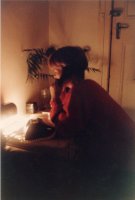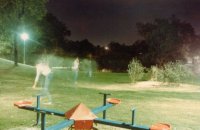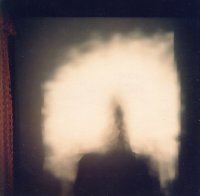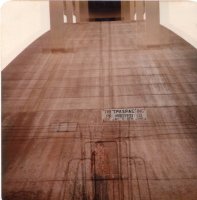People, Dogs and other vertebrates
I've categorised this "People" section based around the techniques required to capture the image and/or the type of result required.
Motionless Subjects
The first type of "people" photo is pretty close in principle to the first ever photographs taken over a century ago.
That is: the subject remains very still and the lens is open for a significant period of time.
If you have a patient and well disciplined subject then the same basic principals apply here as with most photography of stationary objects: the smaller the aperture and the longer the exposure, the clearer the image.
BUT, given that people tend to move simply as a result of breathing and that only masters of meditation have any real hope of holding their breath without moving for any length of time, it's best to go for a shorter exposure and a larger aperture.
Moving naturally
The next type of photograph is again closely related in principal to the old way of taking photos but in this case the subject is moving.
In the old days this was undesirable but sometimes unavoidable if the subject was to be captured.
There were ways to minimise the impact of motion such as taking the photo as the subject moved toward the camera (as opposed to watching it pass).
Today it is almost always possible to avoid this type of blurring but it can have some pleasant effects - arguably more pleasant than if the photo was taken with a flash.
If you plan to photograph a model it's important for them to keep the some part of their being (eg. torso and head) as motionless as possible, depending on the effect you want to create of course.
Ghosts
This can be great fun (depending on who your model is) and there's a lot of scope for inventiveness and unexpected but delightful errors.
It's also very easy to do this on your own - not because you like self portraits, simply because it's easier to experiment if no one's relying on you to get the job over and done with.
Of course you can always encourage your subject to move deliberately, either within or outside the frame of the photo. The results of this can be seen in the photos on the Ghosts page.
Fun with a flash gun
Another technique is the use of a flash gun. For best effect, the environment is usually is naturally dark (a playground in a park with minimal lighting in this example).
The camera is mounted on a tripod, the shutter is opened, and the photographer (or the subject) wanders around with a standard flash gun triggering the flash at strategic locations. You could always just use random flashes if you prefer.
This technmique (with more examples), is discussed further at on the Fun with a flash gun page.
Shadows
Another way of representing people is the humble shadow.
The light source could be natural and clear or filtered through some natural or man made object such as a tree or frosted glass (or both as in this example).
Superimposition
A related techinique (arguably not "bulb") is to expose the film more than once with a common background.
I have discovered that this is almost impossible to do properly, unless you have either an extremely solid tripod (preferably bolted down) or a particular type of camera (preferably both).
The problem is that it is necessary (with most cameras) to handle the camera in order to recock the shutter without winding on the film. The slightest movement of the camera causes the background to be blurred / double imaged.








